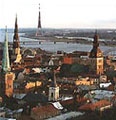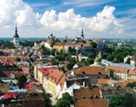The back cover text on the 1994 first edition of the Lonely Planet guide to the Baltic states and Kaliningrad opens with the following: "Perhaps the last frontier of European travel, the Baltic States are a treasure trove of historical, cultural and natural delights." Back in 1994, when that first volume was published, travelling to the Baltic states was considered exotic and akin to a trip to the long-lost frontier. Questions such as "Is it safe?" or "Isn't it a part of Russia?" were common amongst the few that had even considered making a trip to the region. It was only the geographically near locals in Scandinavia who made the region a popular tourism spot, which, in turn, set the foundations for the quantum leap the countries made in both their economy and their international tourist appeal.
It was in January of that same year that I made my very first trip to the region. As warned by many guidebooks and my own common sense, I experienced both the joy of discovery and the anguish of the problems facing the countries. In one country, I remember having no heat and my hotel restaurant being "closed until summer"; yet in another country, I remember a heartfelt embrace from an ageing pensioner for remembering the plight of his people's language. And finally, I also remember how in a third country the shoddy tourism service forgot about my airport transit...
Some six years later, the region has become the most dynamic tourist destination in all of Europe. In late 1999, I retraced my steps (backwards, sensibly enough since I live in Estonia) from early 1994 to see how much things had changed. Though it has been a relatively short period of time for most people around the world, for the Baltics, the changes of these mere six years were phenomenal and rapid.
 |
| View of Riga's Old Town |
The dynamism of the tourism sector's development in the Baltic states soon made guidebooks such as the Lonely Planet less of a necessity. The three capitals are relatively well outfitted to handle foreign tourists, and a plethora of local guides on accommodation, transport, entertainment and local life are available. However, larger guidebooks remain a good overview of the countries, and continue to be very useful for those travelling beyond the perimeters of the capital cities and for more adventurous "take it by the day" travellers.
Even travel guides published several times a year, such as the excellent In Your Pocket series or the City Paper, often become outdated by the next issue: digitalisation changes telephone numbers; companies and embassies move to nicer quarters; new bars and restaurants pop up around town; and timetables change constantly. However, such guides remain the lifeline for many tourists and ex-pats alike, and picking up something such as an In Your Pocket guide upon arrival in any of the Baltic countries is a very, very wise idea - even for seasoned travellers to the region.
 |
| View of Tallinn's Old Town |
All in all, the ability to move through three such distinct countries is a significant advantage for tourists, going from baroque Vilnius to Jugendstil Riga to Hanseatic Tallinn. And as a sign of just how far the markets for local and foreign tastes have developed, the traveller can enjoy an excellent rogan josh in Vilnius, a scrumptious moussaka in Riga, and a hearty gulyás in Tallinn among the sometimes dizzying selection of ethnic cuisine. Such quick but solid introductions to all three countries (albeit via the capitals) give tourists an opportunity to set their own return journeys, and decide to see more of something they prefer out of the three distinct choices.
Unfortunately, tourism co-operation among the three Baltic countries seems to be sharing the same fate as political co-operation. For independent travellers without the planning (and constraints) offered by tourism agencies, going through all three countries could be a harrowing experience. Simply going from capital to capital is a difficult and sometimes uncomfortable endeavour, as most travellers will have little choice but to use the bus system. Though the busses are on par with European standards and generally comfortable, the poor state of the roads (especially from Tallinn to Riga) makes the journey uncomfortable - as do the long delays at the border. Albeit reliable and for most purposes useful, many travellers - especially those past their "backpacking days" - plainly have a preference for train or plane travel.
 |
| View of Vilnius's Old Town |
As in many countries of the world, tourism in the Baltic states is focused on the capital cities. That said, many of the gems outside of the three capitals are unable to keep up with the rapid development in the capitals due to their growing tourism market. However, with more returning visitors, tourism outside Vilnius, Riga and Tallinn is also developing at an increasing pace. These days, travellers can enjoy ecotourism on many of Estonia's nature reserve islands, a castle and ruins tour down the Daugava river in Latvia or the pristine sands of the Couronian Spit on the Lithuanian coast.
At this point, it would perhaps make more sense to look at each of the countries separately. After reading the following brief profiles of each of the Baltic countries, this former tourism writer hopes that both the uniqueness and similarities that travelling the Baltics entails will be enjoyed by the prospective or seasoned tourist to this most unique, former frontier of European travel. For those who have visited the region before, come back and discover the changes; for those who have never visited, you will be pleasantly surprised. The former frontier awaits.
Mel Huang, 6 April 2000
Photos courtesy of: the Latvian Tourism Development Agency, the Estonian Tourist Board and the City of Vilnius.
Baltic Profiles:
General Links:
- The In Your Pocket series of city guides
- City Paper: The Baltic States
- Estravel - the premiere travel agency in the Baltics
Moving on:



